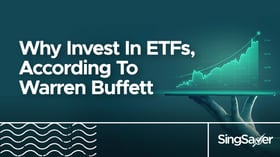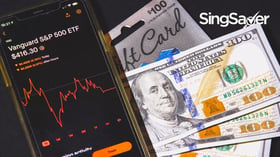Exchange Traded Funds (ETFs) have become a popular investment vehicle amongst both new and seasoned investors. Find out what they are, the types available, and how you can get started.
The ETF market is booming. Global ETF assets are poised to more than double to USD$12 trillion by the end of 2023. Besides being an asset class for retail investors, ETFs are also a hot investment vehicle used by robo-advisors to curate portfolios for their customers.
What are ETFs?
An ETF is a fund traded on the stock exchange, which consists of a basket of securities such as stocks, bonds and commodities. ETFs seek to track the performance of an index such as the S&P 500 Index or the Straits Times Index (STI), making them a great investment choice for passive investing. These ETFs are also listed on financial markets such as the New York Stock Exchange, NASDAQ and Singapore Stock Exchange (SGX).
For example, the STI tracks the top 30 companies listed on the SGX. Rather than individually purchasing stocks such as DBS, CapitaLand, Singtel and Dairy Farm to make up your portfolio, you can instead purchase a single product that is an STI ETF.
Beyond shares, there are also ETFs available for the other asset classes. Read these articles to find the best Singapore ETFs and the best US ETFs.
Here’s what you need to know about investing in ETFs.
Reasons why people invest using ETFs
#1 Diversification
ETFs are a great way to ease yourself into investing if you’re not confident in individual stock picking. With an ETF, you gain exposure to a basket of stocks, bonds or other asset classes depending on the ETF you invest in.
This helps to diversify your portfolio at a low cost. Diversification helps you to reduce your investment risk by not having all your eggs in one basket.
#2 High liquidity
ETFs are traded on the open market. This makes them highly liquid as investors can choose to buy and sell the ETF at any time. All that’s required for you to purchase an ETF is a brokerage account and your Central Depository (CDP) account.
#3 Low barrier to entry
With an ETF, you can invest in top companies at a fraction of the price, without minimum investment amounts.
For example, the STI ETF today ranges around $2.51 while a single stock of a company within the STI, like DBS, stands at about $20. The same applies to other markets. The price of Amazon shares is more than USD$3,000 while the SPDR S&P 500 ETF is priced at USD$328.
From a cost perspective, it could be more expensive for an investor to purchase these individual stocks to make up their own portfolio, compared to purchasing a single ETF that consists of a bucket of stocks.
#4 Wide variety of ETFs available
With thousands of ETFs available on the market, you can choose ETFs from different asset classes, geographies, industries, countries and stock exchanges. How you select your ETFs would depend on your investment goals, preferences and what’s in your current investment portfolio.

SingSaver Exclusive Promotion: Receive S$60 Grab vouchers when you open a moomoo universal account and fund a min. of S$100. Fund a min. of S$2,000 to receive an additional S$100 Grab vouchers (S$160 total) via PayNow. Valid till 2 May 2024. T&Cs apply.
Plus, receive up to S$970 worth of welcome rewards and up to 6.8% p.a. returns when you complete additional actions with your moomoo account. Valid till 1 Jul 2024. T&Cs apply.
Types of ETFs available
Stock ETFs
Stock ETFs refer to ETFs made up of a portfolio of stocks to track an index such as the S&P 500 Index. One of the most popular ETFs available is the SPDR S&P 500 ETF — an ETF that is made up of the common stocks that are included in the S&P 500 index (an index consisting of the largest 500 companies listed on stock exchanges in the US).
Other examples of ETFs that track stock indexes include:
- Invesco QQQ ETF that tracks the Nasdaq 100 Index
- SPDR Dow Jones Industrial Average ETF that tracks the Dow-Jones Industrial Average
Bond ETFs
Bonds or fixed income ETFs are made up of various types of bonds or fixed income products. They are a low-risk asset class that usually appeals to risk-averse investors. While bonds generally have lower returns when compared to stocks, they offer stability to a portfolio with their steady and fixed interest payments.
Examples of bond ETFs include:
- ABF Singapore Bond Index Fund
- Nikko AM SGD Investment Grade Corporate Bond ETF
Commodity ETFs
Commodities can prove to be a good hedge against inflation, and are at times negatively correlated to other asset classes such as stocks and bonds. Commodity ETFs consist of a basket of commodities such as gold, silver and oil. They can also consist of companies that produce agricultural products like corn, grain and livestock.
Examples of commodity ETFs include:
- SPDR Gold Shares ETF
- iShares Silver Trust
- iShares MSCI Global Agriculture Producers ETF

SingSaver Exclusive Promotion: Receive S$60 Grab vouchers when you open a moomoo universal account and fund a min. of S$100. Fund a min. of S$2,000 to receive an additional S$100 Grab vouchers (S$160 total) via PayNow. Valid till 2 May 2024. T&Cs apply.
Plus, receive up to S$970 worth of welcome rewards and up to 6.8% p.a. returns when you complete additional actions with your moomoo account. Valid till 1 Jul 2024. T&Cs apply.
Sector specific ETFs
If you are looking to invest in a specific sector such as real estate, healthcare, technology or energy , you can invest in an ETF instead. An example is Real Estate Investment Trusts (REITs); with dozens of REITs available on the SGX, investors are spoiled for choice. Instead of taking the time to analyse and cherry-pick your REIT winners, you can consider investing in the entire sector with a REIT ETF.
REIT ETFs include:
- NikkoAM-Straits Trading Asia Ex-Japan REIT ETF
- Phillip SGX APAC Dividend Leaders REIT ETF
- Lion-Phillip S-REIT ETF
Beyond REITs, there are also other ETFs available such as the Invesco China Technology ETF that specifically tracks technology stocks in China and the Vanguard Health Care ETF that consists of stocks involved in medical or health care products, services, technology, or equipment.
Country specific ETFs
ETFs are also a great way to increase your exposure to overseas markets. For example, if you’re looking to start investing in Singapore stocks, you can consider an ETF that tracks the STI, such as the SPDR STI ETF or the Nikko AM Singapore STI ETF.
Alternatively, you can gain exposure to popular overseas markets such as the US and China with ETFs that track their markets. Examples include:
- SPDR S&P 500 ETF
- iShares MSCI China ETF
Costs of investing in ETFs
All investments come with a fee. When it comes to the ETFs, here are the costs you have to consider.
- Expense ratio: The annual rate or fee the fund charges on the total assets you hold. This fee helps to cover the cost of portfolio management, administration costs and more.
- Commission fees: Fees paid to the broker when you buy or sell on your brokerage platform. There could also be a minimum commission fee required. The more transactions you make, the more commission fees you incur.
If you are purchasing ETFs listed on US stock exchanges, do note that your dividends and bond coupons will be subject to a 30% US withholding tax.
How to get started?
Now that you have a better idea of what ETFs are and the various types you can invest in, here are three ways you can get started.
Help yourself to better financial shape in the new norm, with SingSaver's all-new Ultimate Savings Guide! Got your free copy yet?
Option 1: Open a brokerage account
Much like other investments you make, such as purchasing a stock on the SGX, you can also purchase an ETF on the open market. To do this, you’ll first need to open a brokerage account as well as a CDP account.
With a brokerage account, you can then purchase an ETF of your choice at a price you’re comfortable with.
Option 2: Start a regular savings plan
A regular savings plan (RSP) is one that allows you to invest a predetermined amount each month, starting from as little as $50. An RSP encourages investors to make regular investments and makes it possible for new investors to get started.
RSPs such as DBS/POSB Invest Saver allow you to invest in ETFs such as Nikko AM STI ETF or ABF Singapore Bond Index Fund. There are also providers such as FSMOne and dollarDEX that allow you to start an RSP by investing in ETFs of your choice.
Option 3: Invest with a robo-advisor
Robo-advisors offer portfolios that are tailored towards your investment goals, preferences and risk appetite. These portfolios typically offer automatic rebalancing and the option for you to add to your portfolio every month.
Some robo-advisors such as Stashaway and Autowealth curate these investment portfolios with ETFs. This allows you to own a portfolio that consists of various types of ETFs through a single investment with the robo-advisor.
Do keep in mind that not all robo-advisors invest using ETFs as some select individual stocks or unit trusts instead.
Much like all other investments, investments come with a degree of risk. Before selecting an ETF to invest in, you should first make sure you have your financial safety nets in place. Your ETF investment can be a little more worry-free if you have your emergency funds down pat, or if you’ve paid off outstanding high-interest rate loans.
Read these next:
Best US Exchange Traded Funds (ETFs) To Invest In (2021)
Best ETFs In Singapore For Tracking Stocks, Bonds And REITs
Guide To Real Estate Investment Trusts (REITs), And Whether You’re Ready For It
Best Robo Advisors To Auto-Pilot Your Investments In Singapore
SPDR STI ETF vs Nikko AM STI ETF: A Comparison In A Jiffy
Similar articles
The 5 Types of Investors You’ll Encounter in Singapore
SPDR STI ETF vs Nikko AM STI ETF: A Comparison In A Jiffy
Best US Exchange Traded Funds (ETFs) To Invest In (2021)
Best ETFs In Singapore For Tracking Stocks, Bonds And REITs
Straits Times Index: Top Blue-Chip Companies (And What They Do)
How to Build a Passive Income Portfolio Using ETFs (And Why You Should)
This Is One S&P 500 ETF You Might Want To Avoid
4 Investing Strategies To Navigate Singapore’s Stock Market










